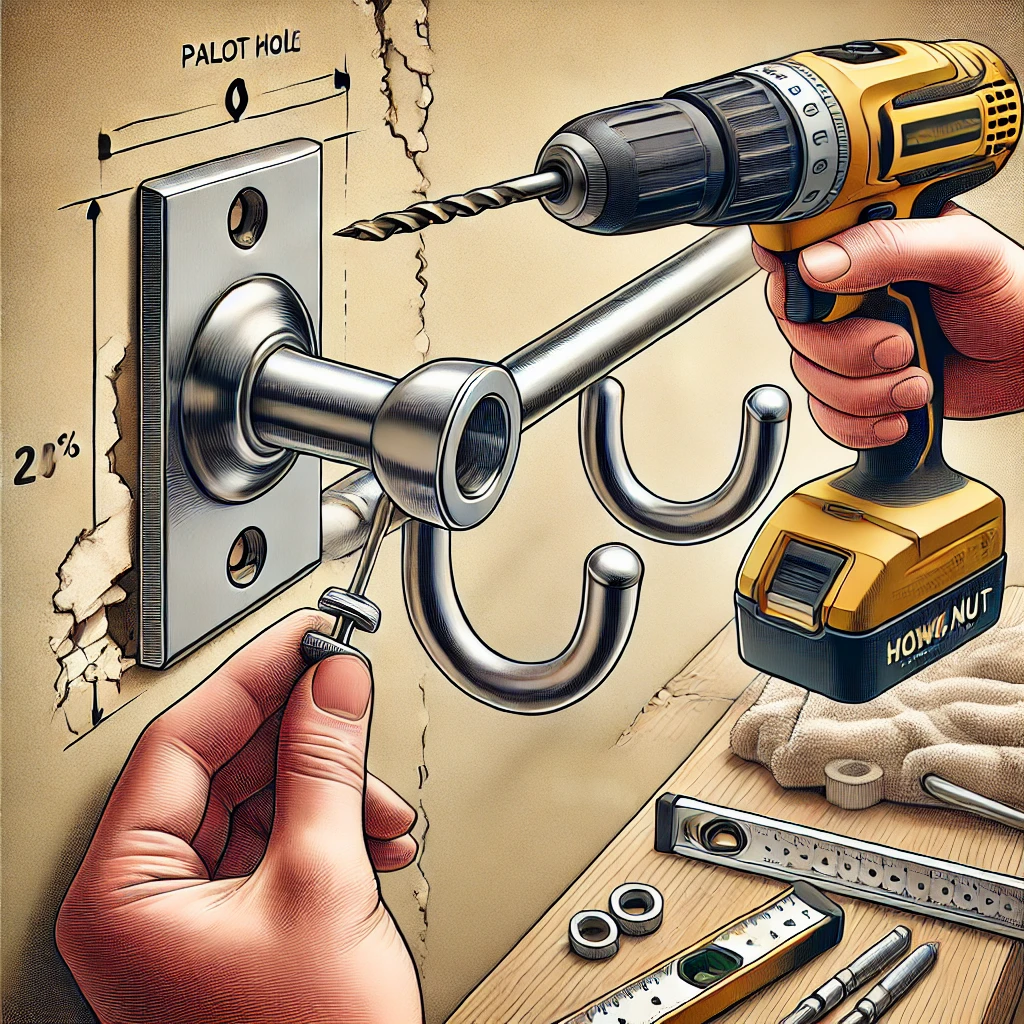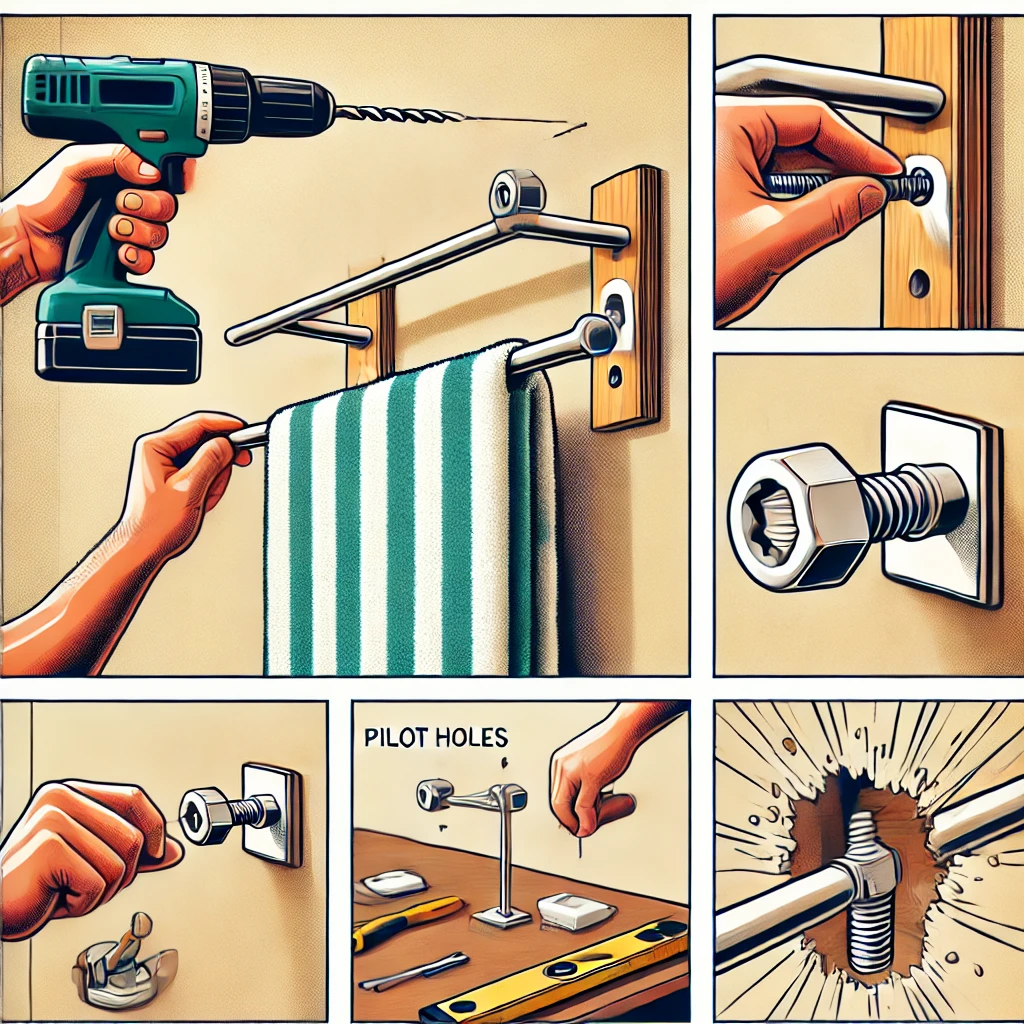How to Install a Towel Rack on Drywall with Wingnuts: A Comprehensive Guide
Introduction
Learning how to install a towel rack on drywall with wingnuts can transform your bathroom into a more functional space while ensuring durability and style. Drywall can be a tricky material to work with due to its delicate nature, but with the right techniques, such as using wingnuts, you can securely fasten a towel rack without risking damage. In this detailed guide, you’ll discover the best practices for using wingnuts, ensuring that your towel rack remains firmly anchored to your drywall.
Understanding the Physics of Installing a Towel Rack on Drywall with Wingnuts
When considering how to install a towel rack on drywall with wingnuts, understanding the mechanics of drywall and wingnut installation is crucial. Drywall is composed of gypsum and paper layers, making it lightweight yet prone to damage under concentrated pressure. This is why simply using standard screws can result in tearing or breaking. Installing a towel rack on drywall with wingnuts addresses this issue by providing a broader, more secure grip behind the wall. Wingnuts, when tightened, expand behind the drywall, offering a stable hold that prevents the towel rack from pulling out over time. Mastering this process is essential for anyone seeking a durable and professional-looking installation.
Choosing the Right Wingnuts for Installing a Towel Rack on Drywall
Selecting the right type of wingnuts is a critical part of understanding how to install a towel rack on drywall with wingnuts. Not all wingnuts are created equal, and the type you choose can significantly affect the success of your installation. For example, standard wingnuts are suitable for lightweight towel racks, while butterfly or toggle wingnuts offer greater support for heavier racks. When learning how to install a towel rack on drywall with wingnuts, knowing the specific needs of your installation is crucial. For heavier racks, toggle wingnuts can expand more behind the drywall, making them ideal for high-traffic bathrooms where stability is paramount.
Step-by-Step Guide: How to install a towel rack on drywall with wingnuts
Step 1: Select the Perfect Spot
When learning how to install a towel rack on drywall with wingnuts, choosing the right location is the first step. The placement should ensure easy access to towels while maintaining visual balance in the room. Using a stud finder, check the area to see if there are any studs behind the drywall. While studs aren’t required when installing a towel rack on drywall with wingnuts, aligning the rack with them can add extra support. Understanding the balance between aesthetic and functional placement is key when figuring out how to install a towel rack on drywall with wingnuts effectively.
Step 2: Mark the Installation Points for Wingnuts
Precision is crucial in how to install a towel rack on drywall with wingnuts. Use a level to ensure that the towel rack will be straight, then mark the points where the screws will go. This step is important for avoiding mistakes during installation. Properly marking these spots ensures that the installation of a towel rack on drywall with wingnuts is secure and aligned. Using a pencil to mark these points helps create a guide for drilling pilot holes, which is a critical part of the process.
Step 3: Drill Pilot Holes and Insert Wingnuts
Drilling pilot holes is a fundamental step in how to install a towel rack on drywall with wingnuts. These holes should match the size of the wingnuts to ensure a snug fit. Drilling too large a hole can lead to loose fittings, compromising the stability of your towel rack. Inserting wingnuts into these pilot holes allows for a tight, secure fit, which is essential when considering how to install a towel rack on drywall with wingnuts. As you tighten the wingnut, the wings spread behind the drywall, creating a firm grip that is difficult to achieve with traditional screws alone.

Step 4: Secure the Towel Rack with Wingnuts
Once the wingnuts are in place, aligning the towel rack is the next step in how to install a towel rack on drywall with wingnuts. Place the rack over the holes and ensure that it is level before inserting the screws through the holes and into the wingnuts. Use an electric drill or a screwdriver to tighten the screws carefully. This is a crucial step in installing a towel rack on drywall with wingnuts, as over-tightening can damage the drywall, while under-tightening may leave the rack unstable.
Avoiding Common Pitfalls When Installing a Towel Rack on Drywall with Wingnuts
One of the most common mistakes in how to install a towel rack on drywall with wingnuts is using the wrong size of wingnuts. A wingnut that is too small won’t provide sufficient support, while one that is too large can cause damage to the drywall. This can result in an insecure installation. When working out how to install a towel rack on drywall with wingnuts, it is essential to select a wingnut that matches the size of your pilot hole and the weight of your towel rack. This ensures that the wingnut will expand properly behind the drywall, providing a secure hold.
Another issue in how to install a towel rack on drywall with wingnuts is failing to drill pilot holes. Skipping this step can cause the drywall to crack when the wingnut is inserted, compromising the installation. When drilling the pilot holes as part of installing a towel rack on drywall with wingnuts, ensure that the hole is slightly smaller than the shaft of the wingnut. This allows the wings to expand behind the drywall without putting too much pressure on the surrounding area.
Advanced Techniques for Installing a Towel Rack on Drywall with Wingnuts
For those who are looking for a more durable solution, there are advanced techniques to enhance how to install a towel rack on drywall with wingnuts. One such technique is the double-wingnut method, which uses two wingnuts for each mounting point. This technique is particularly effective for heavier towel racks and ensures that the installation is secure. By using multiple wingnuts, you can distribute the weight of the rack over a larger area, which is crucial for how to install a towel rack on drywall with wingnuts when dealing with thin or older drywall.
Another advanced approach to how to install a towel rack on drywall with wingnuts is to use drywall anchors in conjunction with the wingnuts. Drywall anchors provide extra support for the wingnuts, creating a more stable base for the towel rack. When learning how to install a towel rack on drywall with wingnuts, combining these methods can be particularly beneficial if your drywall is older or if you expect to hang heavier towels.
Maintaining Your Towel Rack After Installation with Wingnuts
Proper maintenance is a key part of understanding how to install a towel rack on drywall with wingnuts. Even after a successful installation, regular checks are necessary to ensure that the wingnuts and screws remain tight. Over time, the weight of the towels can cause the screws to loosen, especially in humid environments like bathrooms. When learning how to install a towel rack on drywall with wingnuts, make it a habit to periodically check the tightness of the screws to prevent the rack from becoming loose.
Additionally, avoid hanging excessively heavy items on your towel rack. While installing a towel rack on drywall with wingnuts provides a secure hold, it’s important not to exceed the recommended weight limit for the rack. This prevents undue stress on the drywall, maintaining the integrity of the installation.
Enhancing Bathroom Aesthetics with a Properly Installed Towel Rack Using Wingnuts
Understanding how to install a towel rack on drywall with wingnuts not only ensures functionality but can also enhance the overall look of your bathroom. When choosing a towel rack, consider the style and finish that complements your bathroom’s design. From traditional chrome racks to modern matte black finishes, selecting the right design is a crucial step in creating a cohesive look. This knowledge complements how to install a towel rack on drywall with wingnuts, as a securely installed and stylish rack can serve as a focal point in your bathroom.
For those interested in sleek, minimalist designs, learning how to install a towel rack on drywall with wingnuts allows you to confidently choose more elaborate racks that might be heavier or require a more secure hold. With this guide, you can be sure that your towel rack will remain firmly in place, no matter the design or size.
Cost Considerations When Installing a Towel Rack on Drywall with Wingnuts
Understanding the costs involved is an important aspect of how to install a towel rack on drywall with wingnuts. While the cost of wingnuts is relatively low, typically ranging from $5 to $10 for a set, the overall expenses can vary depending on the type of towel rack and tools you choose. A well-made towel rack can range from $20 to $100 or more, depending on the brand and material. When learning how to install a towel rack on drywall with wingnuts, factoring in these costs helps ensure that your project remains within budget.
If you decide to hire a professional for installing a towel rack on drywall with wingnuts, labor costs can range from $50 to $100, depending on the complexity of the job. However, with a solid understanding of how to install a towel rack on drywall with wingnuts, many homeowners can save money by tackling this project themselves, using the right tools and techniques for a successful installation.
Conclusion: Mastery of How to Install a Towel Rack on Drywall with Wingnuts
Mastering how to install a towel rack on drywall with wingnuts can greatly enhance your DIY skills and add functional style to your bathroom. Wingnuts provide a secure and reliable method for attaching racks to drywall, ensuring that they stay in place without risking damage to the wall. With the techniques and knowledge provided in this guide, you can confidently take on the task of installing a towel rack on drywall with wingnuts, knowing that the end result will be both durable and visually appealing.
By focusing on precision, selecting the right type of wingnuts, and avoiding common mistakes, you can ensure that your towel rack installation remains sturdy for years to come. Whether you’re refreshing an old bathroom or building a new space, knowing how to install a towel rack on drywall with wingnuts is a valuable skill that adds both utility and aesthetic appeal to your home.




